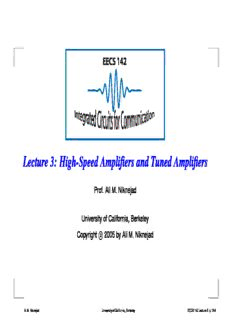
High-Speed Amplifiers and Tuned Amplifiers PDF
Preview High-Speed Amplifiers and Tuned Amplifiers
EECS 142 Lecture 3: High-Speed Amplifiers and Tuned Amplifiers Prof. Ali M. Niknejad University of California, Berkeley Copyright (cid:13)c 2005 by Ali M. Niknejad A.M.Niknejad UniversityofCalifornia,Berkeley EECS142Lecture3 p.1/44 –p.1/44 CS/CE Amplifier Bandwidth R L C + µ v o R S − + C + C v db L s − Due to Miller multiplication, the input cap is usually the dominant pole 1 ω R (C + A C ) 0− s in v µ ≈ | | 1 ω = R C (1 + µ A ) R C µ A 0− s in v s in v | | ≈ | | A.M.Niknejad UniversityofCalifornia,Berkeley EECS142Lecture3 p.2/44 –p.2/44 CS/CE Amplifier Gain-Bandwidth Assuming the voltage gain is given by the low-frequency value of g R , we have m L C 1 in ω = R C µg R = (g R )(g R ) µ 0− s in m L m s m L g m R 1 2 s 1 ω = A ω µ 0− v − T | | R L 2 The amplifier has a bandwidth reduction factor of A v R 1 2 L ω A = ω 0 v T × | | × R × µ s (cid:18) (cid:19) A.M.Niknejad UniversityofCalifornia,Berkeley EECS142Lecture3 p.3/44 –p.3/44 Bandwidth Example R Say we need a gain of 60 dB (A = 1000) and L = 2. v R s The technology has a capacitance ratio of µ = 0.2: 2 6 ω A = 10 ω = ω 2 5 0 v 0 T | | × × ω T ω = 0 5 10 Compare this to a current mirror amplifier. When we follow the “normal” gain-bandwidth tradeoff, we have ω ω T T ω = = 0 A 1000 i A.M.Niknejad UniversityofCalifornia,Berkeley EECS142Lecture3 p.4/44 –p.4/44 Common Base Amplifier C µ + R Cin vin gmvin ro L R S − + vs RL − R S + v s − Write KCL at base node of circuit v + v s in +g v +sC v = 0 v = v (1+g R +sC R ) m in in in s in m s in s R s A.M.Niknejad UniversityofCalifornia,Berkeley EECS142Lecture3 p.5/44 –p.5/44 Common Base Amp (cont) And write KCL at the output node 1 (sC + )v + g v + sC v = 0 o o m in µ o R L 1 v + s(C + C ) = g v o o µ m in R L (cid:18) (cid:19) The voltage gain is a product of two terms v g R v o m L x A = = v v 1 + s(C + C )R v s o µ L s G R m L A = v C (1 + s(C + C )R )(1 + sR in ) o µ L s 1+g R m s A.M.Niknejad UniversityofCalifornia,Berkeley EECS142Lecture3 p.6/44 –p.6/44 Common Base Bandwidth Note the transconductance is degenerated, G = g /(1 + g R ). Note that the input capacitance is m m m s also degenerated by the action of series feedback. Unlike a CE/CS ampilifier, the poles do not interact (due to absence of feedback capacitor) First let’s take the limit of high loop gain, g R 1 m s ≫ R L R A = s v (1 + s/ω )(1 + s/ω ) T L 1 where ω = ((C + C )R ) is the pole at the output. L o µ L − A.M.Niknejad UniversityofCalifornia,Berkeley EECS142Lecture3 p.7/44 –p.7/44 Matched Common Base Amp The common-base amplifier has the nice property that the input impedance is low (roughly 1/g ) and m broadband, thus easily providing a termination to the driver (a filter, the antenna, or a previous stage). If we assume that R = 1/g , we have s m 1 g R 2 m L A = v (1 + s/2ω )(1 + s/ω ) T L The 3dB bandwidth is thus most likely set by the time constant at the load. A.M.Niknejad UniversityofCalifornia,Berkeley EECS142Lecture3 p.8/44 –p.8/44 Shunt Feedback Amp V CC R L R F v o R C S ∞ + v s − The shunt-feedback amplifier is a nice high-frequency broadband amplifier building block. The action of the shunt feedback is used to lower the input impedance and to set the gain. A.M.Niknejad UniversityofCalifornia,Berkeley EECS142Lecture3 p.9/44 –p.9/44 Shunt Feedback Gain / Input Resis The in-band voltage gain and input impedance is given by (see PS 1) R F A = v R s R 1 F R = (1 + ) in R g L m R 1 R For an input match, R = (1 + F ) , or g R = (1 + F ) s m s R g R L m L Since the voltage gain sets R , the input impedance F match determines the required transconductance g m (and hence the power dissipation) A bipolar version will dissipate much less power due to the higher intrinsic g m A.M.Niknejad UniversityofCalifornia,Berkeley EECS142Lecture3 p.10/44 –p.10/44
Description: